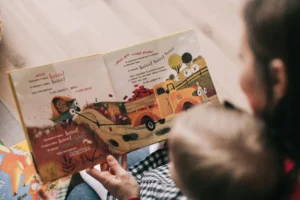As parents, most often we get “me time” when our little ones are asleep for the night. Their sleep time is our chance to wind down and relax, and maybe watch something that doesn’t involve a catchy song that gets stuck in our head for hours. (I’m looking at you, Baby Shark!)
Until we realize that instead of rest, our little ones are experiencing a bad dream or resistance to sleep, or fussing. So how do we know if they’re having a bad dream? Or just being fussy? Or if it’s something worse, like nightmares and night terrors?
Bad Dream vs Nightmare
A bad dream is a dream that comes on quickly and leaves just as fast, without disturbing your child’s sleep that night. Bad dreams don’t wake your kiddo. Think about it: as adults, we may remember bits of a bad dream the next day but, unless we write it down, it’s often forgotten. Likewise, children almost never remember their bad dreams. If they do, don’t encourage them to tell you all about it. Why draw unnecessary attention to an unpleasant experience?
A nightmare is a dream that can bring on extreme feelings of distress, fear, terror and anxiety, depending on brain activity. Nightmares cause us to wake up and continue to feel these feelings. Your child may call out for you or come to your room in distress. They may often remember the dream and be able to tell you about it in little or full detail, depending on their age.
What causes nightmares in our children?
In children ages 2-4, it’s more common for them to have nightmares that stem from an activity, such as teasing by an older sibling (monster under the bed anyone?), or seeing something in their daily activities that may trigger a fear response in them. Your littles watch EVERYTHING you do, so they can even be subconsciously paying attention to what you are watching, which can have an impact. They’re like sponges at this age, soaking up so many pieces out of each day from various experiences. It’s hard for them to distinguish between what is real and what is not.
Even everyday, “normal” occurrences that help them learn and grow can cause triggers in your child. Natural progressions, such as changing from a crib to a bed or sitting in a booster seat instead of a highchair, can stress or overwhelm a child without you realizing it.
By the age of 6 and sometimes even younger, there are other factors such as watching the news that can trigger a reaction. Our kids pay attention to more than we realize. Hearing daily news updates, our banter about certain stories, and our responses to them, can stir an idea that may stand out to them. It only takes a thought to start an idea, which can create a fear in their subconscious that is later triggered as a nightmare or night terror.
With all this said, the number one reason for both nightmares and night terrors is often linked to overtiredness in a child.
None of this is meant to scare you, or make you feel like you are causing stress in your child, or that you are the reason for their nightmares. Please understand, we share this information so that you understand more about what is happening to your child, and what can trigger a reaction. There are so many different reasons that our toddlers or children react the way they do, and it is not a reflection of your parenting, your actions, or your daily life. It is just meant to raise awareness so if your child suffers from nightmares or night terrors, you have the education in place to help you and your child.
Reactions to Nightmares
When your child is waking up from a nightmare, they may cry, scream, yell, or in a sleepy daze, try to get out of bed and away from the situation. Here are some tips for helping your child after a nightmare.
- Go to your child as soon as you realize what is happening.
- Comfort them, and sooth their fears. Let them know that you will not let anything happen to them, and they are safe in their room.
- If they want to talk about it, let them, but don’t add unnecessary vocabulary by encouraging them to talk in depth about something.
- If they do not have a night light, adding one with a soft light where the light is indirect and not shining on anything that can distract them from sleep.
- Ask them if there is something in the room that is scaring them, and if so, remove if possible, or show them that it is safe and nothing to be afraid of.
In addition, there are several changes you can make to help reduce the number of nightmares your child is having.
- Be aware of what cartoons or shows may be triggering them. Are there monsters in a cartoon that may seem harmless, though to your child they are scary?
- Limit screen time. Too much stimulation on any device that they can play on may need to be reduced or even taking a break from it until you find the trigger for their nightmares.
- Start a journal of behaviors you are noticing that are not normal for your little one. Are they more aggressive after a certain show? Are they acting out or having a tantrum after a certain activity? If they still nap, are they getting enough, or even too much, sleep?
- Talk to their pediatrician if you feel that you have done what you can at home, and nothing has changed with their nightmares.
- Adjust their bedtime EARLIER to account for overtiredness.
Nightmare vs Night Terror
As an adult, we know a bad dream can awaken us and create feelings of anxiety and uneasiness. In a child, a night terror is a far more dramatic of a reaction than a nightmare. If you witness your child having a night terror, it can be scary for both you and your child. Signs of a night terror include:
- Abrupt awakening, causing your child to sit up, jump up, or try to get out of bed.
- Scream, yell, or shout in terror.
- May be breathing really fast or have an extremely fast heartrate or pulse.
- May be very sweaty, from head to toe.
- They may be thrashing around their bed, kicking, or moving their bodies often.
- Are incredibly upset, scared and confused and often not aware of their surroundings
Because night terrors are different than nightmares, typically happening in the deepest sleep stage, they may wake up the next day have zero recollection of it, and unlike a nightmare, they have no memories of what they might have been afraid of. All you will know from watching them or seeing it on the baby monitor is that it happened.
So, what causes night terrors?
Medically speaking, night terrors in children are cause by over-arousal of their Central Nervous System (CNS), while they are asleep, and occur in specific stages of sleep cycles.
At this point, you are probably trying to remember all the sleep cycles we go through as we were taught in science class, and because most of us stored that information in a part of our mom/dad brain we do not use anymore, I am here to help you out. At Rocky Mountain National Baby, we are more than just sleep training, we dabble in science refreshers, too, just for you.
- First stage: drowsiness. Eyes start to get heavy and open and close.
- Second stage: is the light sleep where we drift in and out of sleep and wake up easily. (I think I can speak for all of us new or parents of young ones, this is our most common sleep cycle!)
- Third stage: You are now in deep sleep. Extremely slow brain waves called “delta waves” are intermixed with smaller, faster brain waves.
- Fourth stage: You stay in a deep sleep and your brain is almost exclusively producing those delta waves we just learned about in stage four.
- Fifth stage: You are in the final sleep cycle called “REM” or Rapid Eye Movement due to the intense dream and brain activity you go through at this stage. This stage is also where you briefly wake up 4-6x a night.
It is important to note that children typically have nightmares in the REM cycle. Night terrors happen as our children enter into the fifth stage of their sleep cycle, when have been asleep for about 2 – 3 hours. Usually, it is a smooth transition between cycles, however, when it is not, night terrors can occur, leaving your child frightened, upset, and reacting in a temperamental manner.
Keep in mind, night terrors are rare, happening only 3% to 6% of children ages 3 to 12. If a family member had night terrors as a child, or is a known sleepwalker, the risk of your child having sleep terrors is higher. If your child is experiencing night terrors, and neither parent had them, they may be a one-time situation, or it can happen a few times, before they stop on their own just as quickly as they started.
If your child is experiencing night terrors, please know, you are not alone. It can be scary, and if repeating nightly, exhausting for both you and your child.
If you need someone to talk to, call us at Rocky Mountain Sleeping Baby. We are happy to discuss your situation and see if it is one, we can help with, and if not, work with you to talk to your pediatrician for further help.
There are some solutions that can be beneficial to helping reduce or eliminate night terrors in your child:
- Do not try to wake your child up during a night terror. It typically will not work, and if you do happen to awaken your child, you are creating a very disoriented and confused child who may have a hard time going back to sleep.
- Reduce the stressors that are triggering your child.
- Create a bedtime routine that eliminates screen time at least 60 minutes before bed, and involves a soothing, calm transition to bed.
- Is your child getting enough sleep?
- Is your child staying up too late?
You can also keep a diary for a week and log everything from the moment your child wakes up and include activities, meals, play time, screen time, etc., being sure to mark down their mood with each activity, and the time. This can help you eliminate what could be causing the night terror.
Remember, while not common, it is possible your child can have a night terror, and if so, know that there are plenty of resources to help you, including Rocky Mountain Sleeping Baby.
We know that there are so many options out there for your child’s sleep needs and we are thankful that you put your trust into Rocky Mountain Sleeping Baby and allowing us to share information with you that may come in handy to you, or someone you know. If there is a topic you would information on that we have not covered, please let us know!
We work with families all over the world! We personally are located in Denver, Parker, Arvada, Aurora, Englewood, Kansas City, and Fort Worth, TX.





